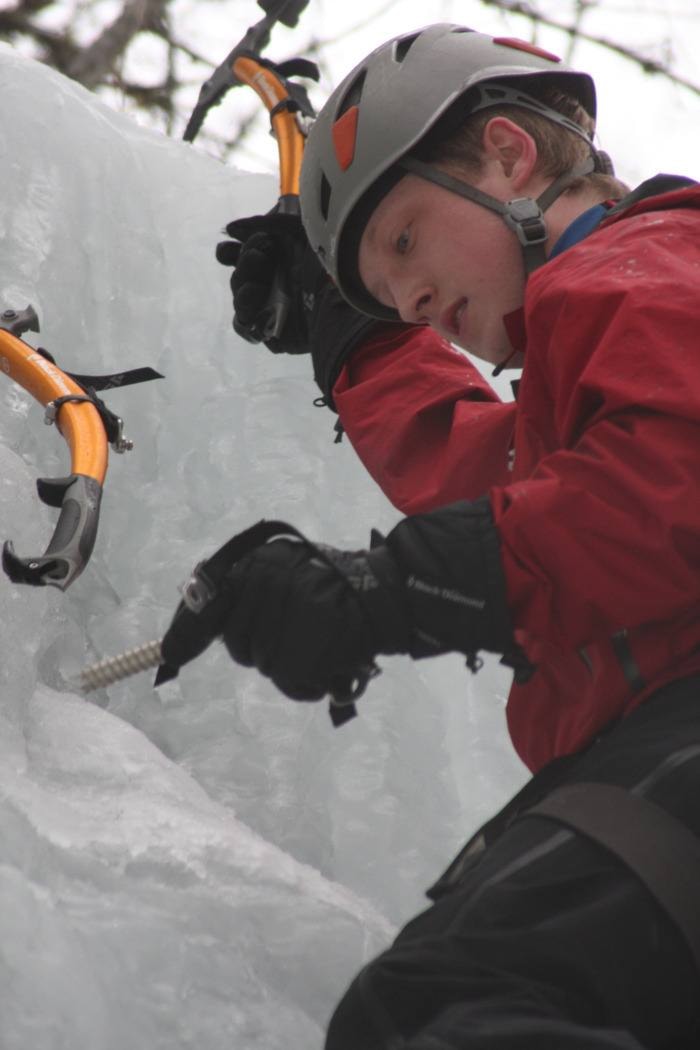For local mountaineers, ice climbing is a way to stay vertical in the winter, while offering an opportunity to hack into icy untouched wilderness.
Although similar in nature to rock climbing, ice climbing requires a new set of gear and a whole new set of rules when it comes to safely navigating a climb.
“Climbing in general or mountaineering is all about calculated risks,” said Andrew Johnstone, 22, one of the few Terrace locals who ice climbs.
Johnstone climbs a variety of ice forms, from frozen waterfalls to rock covered with water that has seeped out during warmer weather and then frozen into pillars and different shapes.
He says he even climbs pillars that are detached, like large climbable icicles.
“It just seemed like a really cool unique thing to do,” Johnstone said in regards to what piqued his interest in the sport.
When ice climbing, climbers wears spiked boots to kick into the ice, and use small pick-axe tools to pull themselves up.
Safeguards can be a stationary anchor placed at the top of a climb, or ice screws, which climbers would put in the ice as they climb.
Johnstone said climbing ice is much more delicate than climbing rock. A climber has to be cautious of where to sink the pick, as ice can “dinner plate,” which is where sections crack and fall off.
Since ice climbs often occur in paths of water drainage, avalanches are a concern for climbers.
Weather is also a factor as running water behind a sheet of ice can be a hidden danger.
Johnstone estimates the ice climbing community in Terrace to be miniscule, saying he only personally knows of four others, and estimates there could not be more than 10 – 15 in total.
He said local ice climbing opportunities are relatively undiscovered compared to other places in B.C., adding that some winters Terrace can have ice comparable to Banff or Jasper, although on a smaller scale and without the lineups.
Johnstone has been an ice climber for two years. He got into it on his own, travelling to Smithers to train and then self-taught with books, practising techniques in his backyard.
He next hooked up with other ice and rock climbers in Terrace to learn more.
“The old-school way is find someone older and more experienced and do a mentorship,” Johnstone said, adding most climbers are willing to pass on their knowledge.
Andy Lecuyer is another local ice climber.
He has been rock climbing in general for 20 years.
Lecuyer said the sport has taken him across the world and shaped the person he is today.
He initially resisted ice climbing because it seemed unstable and required a lot of new gear, estimating the-start up gear for ice climbing to cost anywhere between $1,000 - $2,000.
“My first reaction was scared to get committed, h Lecuyer said. gFriends talked me into it, and I instantly got hooked. h
According to Lecuyer, experience is vital when it comes to reading the ice and weather conditions during ice climbing.
Lecuyer has climbed all over the area, but said some of his best climbs have been on the highway to Prince Rupert.
Lecuyer agreed with Johnstone on the number of climbers.
“I could count on my hand about six, but people have been climbing here off and on since the 80’s,” he said.
“It’s a beautiful thing,” Lecuyer said. “And every ice climb is different.”
